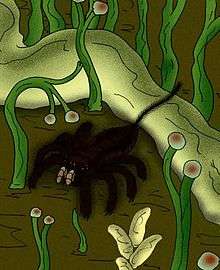Uraraneida
Uraraneida is an extinct order of arachnids, known from fossils of Middle Devonian, Permian and possibly Cretaceous age. Two genera of fossils have been definitively placed in this order: Attercopus from the Devonian of United States and Permarachne from the Permian of Russia. In 2018, a third genus Chimerarachne, from the Cretaceous of Myanmar was proposed to belong to this group, but this placement is disputed. When the first fossils were found, they were identified as spiders, but now constitute the Uraraneida, a separate but closely related group.[1]
| Uraraneida | |
|---|---|
 | |
| artist's reconstruction of Attercopus | |
| Scientific classification | |
| Kingdom: | Animalia |
| Phylum: | Arthropoda |
| Subphylum: | Chelicerata |
| Class: | Arachnida |
| Clade: | Tetrapulmonata |
| Order: | †Uraraneida Selden & Shear, 2008 |
| Genera | |
| |
Characteristics
The first fossil now placed in the order was found in Gilboa, New York. In 1987, it was initially tentatively placed in the extinct order Trigonotarbida and named Gelasinotarbus? fimbriunguis.[2] Later, partly on the basis of a supposed spinneret, it was identified as a spider and named Attercopus fimbriunguis.[3] Further specimens of this species were found, and when examined in detail, along with those assigned to the genus Permarachne, features inconsistent with their placement as spiders were revealed. Silk producing spigots are present, but are borne along the rear edges of ventral plates, not on appendage-like spinnerets, as in spiders. The specimens also have a long, jointed "tail" or flagellum at the end of the abdomen, after the anus, a feature lacking in spiders but present in some other arachnids, such as uropygids.[1]
Phylogeny and classification
A 2014 study placed the Uraraneida in the Tetrapulmonata, a clade of arachnids defined by the apomorphy (derived feature) of two pairs of book lungs. The Tetrapulmonata divide into two main clades, one of which, Serikodiastida (Greek for "silk workers"), unites Uraraneida and Araneae (spiders), groups that share the ability to produce and use silk.[4]
An alternative classification suggested by Wunderlich in 2015, based on the same phylogeny, makes Uraraneida a suborder of Araneae, with "true spiders" treated as suborder Araneida.[5]
| Selden et al. | Wunderlich |
|---|---|
clade Serikodiastida
|
order Araneae
|
In 2016, a fossil arachnid from the Pennsylvanian ("Late Carboniferous") age was described under the name Idmonarachne brasieri. It resembles uraraneids in lacking spinnerets, but unlike them resembles spiders in lacking a flagellum. The Late Carboniferous appears to be a time when there was a greater diversity of tetrapulmonate arachnids, of which the uraraneids were just one group.[6] In 2018, two groups simultaneously published a new taxon which was considered either closely related to[7] or a member of[8] the Uraraneida.
Genera and species
Dunlop et al. (2015) accepted two species:[9]
- Attercopus Selden & Shear, 1991
- Attercopus fimbriunguis (Shear, Selden & Rolfe, 1987) – Devonian; Gilboa, New York
- Permarachne Eskov & Selden, 2005
- Permarachne novokshonovi Eskov & Selden, 2005 – Permian; Matveyevka, Perm Krai, Russia
Huang et al. (2018) placed another species in this order:[8]
- Chimerarachne
- Chimerarachne yingi – mid-Cretaceous; Burmese amber
References
- Selden, P.A.; Shear, W.A. & Sutton, M.D. (2008), "Fossil evidence for the origin of spider spinnerets, and a proposed arachnid order", Proceedings of the National Academy of Sciences, 105 (52): 20781–20785, doi:10.1073/pnas.0809174106, PMC 2634869, PMID 19104044
- Shear, William A.; Selden, Paul A.; Rolfe, W.D.I.; Bonamo, Patricia M. & Grierson, James D. (1987), "New terrestrial arachnids from the Devonian of Gilboa, New York", American Museum Novitates, 2901: 1–74, hdl:2246/5166
- Selden, Paul A.; Shear, William A. & Bonamo, Patricia M. (1991), "A spider and other arachnids from the Devonian of New York, and reinterpretations of Devonian Araneae", Palaeontology, 34: 241–281
- Garwood, Russell J. & Dunlop, Jason (2014), "Three-dimensional reconstruction and the phylogeny of extinct chelicerate orders", PeerJ, 2: e641, doi:10.7717/peerj.641, PMC 4232842, PMID 25405073
- Wunderlich, J. (2015), "On the evolution and the classification of spiders, the Mesozoic spider faunas, and descriptions of new Cretaceous taxa mainly in amber from Burmese (Burma) (Arachnida: Araneae)", in Wunderlich, J. (ed.), Beiträge zur Araneologie, 9, p. 21, cited in Dunlop, Penney & Jekel (2015, p. 127)
- Garwood, Russell J.; Dunlop, Jason A.; Selden, Paul A.; Spencer, Alan R.T.; Atwood, Robert C.; Vo, Nghia T. & Drakopoulos, Michael (2016), "Almost a spider: a 305-million-year-old fossil arachnid and spider origins", Proceedings of the Royal Society B, 283 (1827): 20160125, doi:10.1098/rspb.2016.0125, PMC 4822468, PMID 27030415
- Wang, Bo; Dunlop, Jason A.; Selden, Paul A.; Garwood, Russell J.; Shear, William A.; Müller, Patrick; Lei, Xiaojie (2018), "Cretaceous arachnid Chimerarachne yingi gen. et sp. nov. illuminates spider origins", Nature Ecology & Evolution, 2 (4): 614–622, doi:10.1038/s41559-017-0449-3, ISSN 2397-334X, PMID 29403075
- Huang, Diying; Hormiga, Gustavo; Cai, Chenyang; Su, Yitong; Yin, Zongjun; Xia, Fangyuan; Giribet, Gonzalo (2018), "Origin of spiders and their spinning organs illuminated by mid-Cretaceous amber fossils", Nature Ecology & Evolution, 2 (4): 623–627, doi:10.1038/s41559-018-0475-9, ISSN 2397-334X, PMID 29403076
- Dunlop, J.A.; Penney, D.; Jekel, D. (2015), "A summary list of fossil spiders and their relatives" (PDF), World Spider Catalog, Natural History Museum Bern, retrieved 2016-03-20